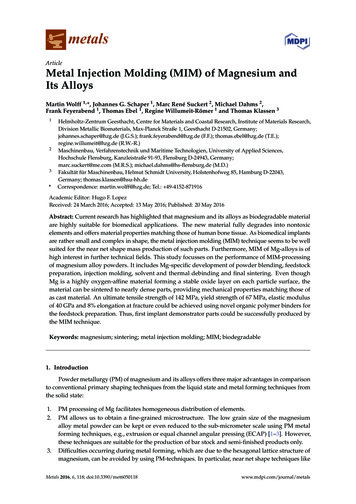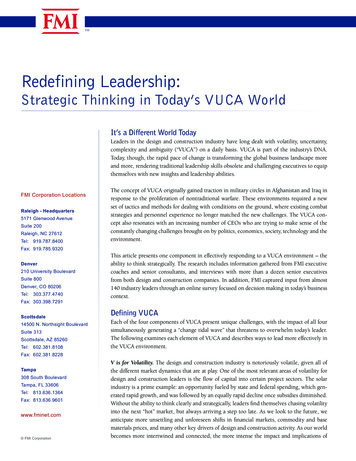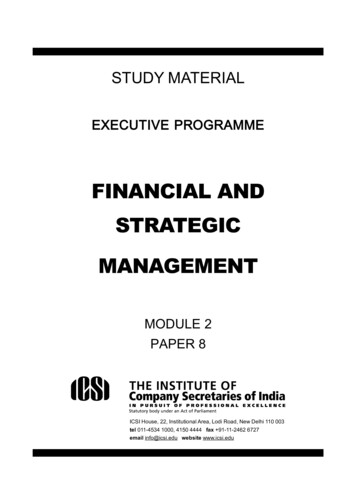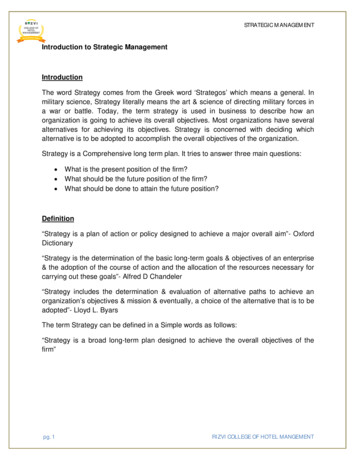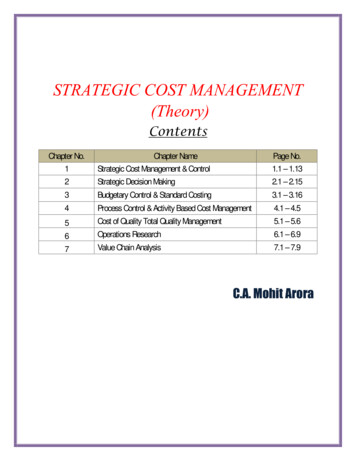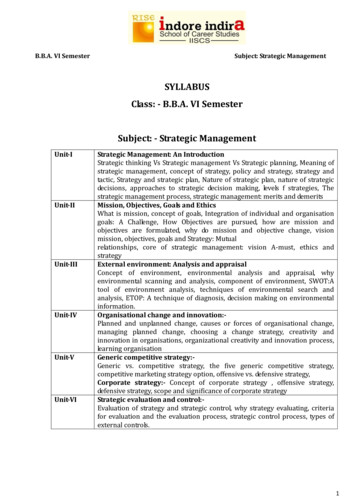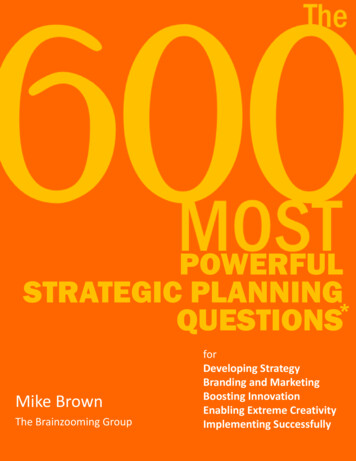
Transcription
Strategic Management ategyImplementation:Evaluationand Control:GatheringInformationDevelopingLong-range PlansPutting Strategyinto nd ThreatsNaturalEnvironment:Resources andclimateSocietalEnvironment:General forcesTaskEnvironment:MissionReason forexistenceObjectivesWhatresults toaccomplishby whenStrategiesPlan toachieve themission &objectivesPoliciesBroadguidelinesfor decisionmakingIndustry analysisProgramsActivitiesneeded toaccomplisha planBudgetsCost of theprogramsProceduresSequenceof stepsneeded todo the jobInternal:Strengths andWeaknessesStructure:Chain of commandCulture:Beliefs, expectations,valuesResources:Assets, skills,competencies,knowledgeFeedback/Learning: Make corrections as neededPerformanceActual results
THIRTEENTH EDITIONStrategicManagementand BusinessPolicyTOWARD GLOBAL SUSTAINABILITY
This page intentionally left blank
THIRTEENTH EDITIONStrategicManagementand BusinessPolicyTOWARD GLOBAL SUSTAINABILITYThomas L. WheelenJ. David HungerFormerly with University of VirginiaTrinity College, Dublin, IrelandIowa State UniversitySt. John’s Universitywith major contributions byKathryn E. WheelenAlan N. HoffmanBentley UniversityBoston Columbus Indianapolis New York San Francisco Upper Saddle RiverAmsterdam Cape Town Dubai London Madrid Milan Munich Paris MontrealToronto Delhi Mexico City Sa o Paulo Sydney Hong Kong Seoul Singapore Taipei Tokyo
Editorial Director: Sally YaganEditor in Chief: Eric SvendsenSenior Acquisitions Editor: Kim NorbutaEditorial Project Manager: Claudia FernandesEditorial Assistant: Carter AndersonDirector of Marketing: Patrice Lumumba JonesSenior Marketing Manager: Nikki Ayana JonesMarketing Assistant: Ian GoldSenior Managing Editor: Judy LealeProduction Project Manager: Becca GrovesSenior Operations Supervisor: Arnold VilaOperations Specialist: Cathleen PetersenCreative Director: Blair BrownSenior Art Director/Supervisor: Janet SlowikCover Designer: Liz HarasymcukCover Photo: Courtesy of NASA/ShutterstockInterior Designer: Maureen EideMedia Project Manager, Editorial: Denise VaughnMedia Project Manager, Production: Lisa RinaldiFull-Service Project Management: Emily Bush,S4Carlisle Publishing ServicesComposition: S4Carlisle Publishing ServicesPrinter/Binder: Courier/KendalvilleCover Printer: Lehigh-Phoenix Color/HagerstownText Font: 10/12 Times RomanCredits and acknowledgments borrowed from other sources and reproduced, with permission, in this textbookappear on the appropriate page within text.Copyright 2012, 2010, 2008, 2006, 2004 by Pearson Education, Inc., publishing as Prentice Hall. Allrights reserved. Manufactured in the United States of America. This publication is protected by Copyright, andpermission should be obtained from the publisher prior to any prohibited reproduction, storage in a retrievalsystem, or transmission in any form or by any means, electronic, mechanical, photocopying, recording, orlikewise. To obtain permission(s) to use material from this work, please submit a written request to PearsonEducation, Inc., Permissions Department, One Lake Street, Upper Saddle River, New Jersey 07458, or you mayfax your request to 201-236-3290.Many of the designations by manufacturers and sellers to distinguish their products are claimed as trademarks.Where those designations appear in this book, and the publisher was aware of a trademark claim, the designationshave been printed in initial caps or all caps.Library of Congress Cataloging-in-Publication DataWheelen, Thomas L.Strategic management and business policy : toward globalsustainability / Thomas L. Wheelen, J. David Hunger. — 13th ed.p. cm.Includes bibliographical references and index.ISBN-13: 978-0-13-215322-5ISBN-10: 0-13-215322-X1. Strategic planning. 2. Strategic planning—Case studies.3. Sustainability. I. Hunger, J. David, II. Title.HD30.28.W43 2012658.4'012—dc22201101354910 9 8 7 6 5 4 3 2 1ISBN 10:0-13-215322-XISBN 13: 978-0-13-215322-5
Dedicated toKATHY, RICHARD, AND TOMBETTY, KARI AND JEFF, MADDIE ANDMEGAN, SUZI AND NICK, SUMMER ANDKACEY, LORI, MERRY AND DYLAN,AND WOOFIE (ARF!).SPECIAL DEDICATION TO KATHRYN WHEELEN:Kathryn has worked on every phase of the case section of this book. Until this edition, she also managedthe construction of the Case Instructor’s Manual. She has done every job with a high level of dedicationand concern for both the case authors and the readers of this book.
This book is also dedicated to the following Prentice Hall/Pearson salesrepresentatives who work so hard to promote this book:NOLA AKALAKASEY CROCKETTBRIDGET HANNENBERGDAVID ALEVYDAN CURRIERBRYAN HARRELLTARA ALGEOKELLY DANTARA HARTLEYDAVID ARMSTRONGMICHLENE DAOUD HEALYKENNY HARVEYMIKE ASKEWSTACY DAVISALISON HASKINSLAURA BAILEYFRANK DEL CASTILLOCAROL HAWKSNICK BAKERMEREDITH DELA ROSAJENNIFER HEILBRUNNALICIA BARNESCHRIS DELANEYCHRISTINE HENRYASHLEY BARNESGEORGE DEVENNEYLYNN HICKSALICE BARRDANA DODGE (Frick)JULIE HILDEBRANDSHERRY BARTELKATE DOLDERDAUNNE HINGLEKENDRA BASSIBARBARA DONLONWENDI HOLLANDJAY BECKENSTEINHEIDI DRESSLERCHRISTY HUMENIUKJOSH BECKENSTEINTRACY DYBALSKIGENE HUMENIUKNICOLE BELLBRIAN DYKANDREA IORIOCATHY BENNETTKIM ECKSUSAN JACKSONKATIE BOLLINTRISH EICHHOLDPAM JEFFRIESSCOTT BORDENKRISTIN ELBERBRITTANY JUCHNOWSKIJENNIFER BOYLEKELSEY ELLIOTTANJALI JUSTUSAUNDREA BRIDGESKATIE EYNONCHERYL KABBSUZANNE BROWNGENEVA FARROWLAURA KAPPESALEXANDRA BUEHLERMARIA FELIBERTYGIA KAULKYLE BURDETTEMIKE FINERJULIE KESTENBAUMWHITNEY CAMERONMICHELLE FINNERTYKARTAPURKH KHALSARUTH CARDIFFCANDAS FLETCHERKIM KIEHLERAMY CAREYROBERT FLORYAMANDA KILLEENMEGAN CARRICOMARCIA FLYNNWALT KIRBYMARTI CARTERBRAD FORRESTERMARY-JO KOVACHANDREA CATULLO-LINNMARGARET FRENCHROBYN KOVARMEREDITH CHANDLERSTEPHANIE FRITSONGREG KRAMPLUKE CLAEYSMARK GAFFNEYDANIEL KRAUSSKAYLEE CLAYMOREMICHELLE GARCIA-JUCHTERMICHAEL KRISANDABRIAN COBBSYBIL GERAUDGINA LaMANTIAJENNIFER COLEAMBER GOECKECHAFIKA LANDERSTARYLL CONNOLLYCAROLYN GOGOLINDOROTHY LANDRYTHAYNE CONRADADAM GOLDSTEINDUSTIN LANGEDONNA CONROYBETH GRUNFELDALIX LaSCOLACAITLIN COUTHENMICAELA HAIDLEJOE LEEMEGAN JOY COWARTGREG HAITHAPRIL LEMONSCYNDI CRIMMINSDEMETRIUS HALLKIMBERLY LENAGHANvi
DEDICATIONTRICIA LISCIOCOLLEEN O’DELLMARY SHAPIROBETH LUDWIGDEBBIE OGILIVEBARBARA SHERRYCARY LUNASARI ORLANSKYKEN SHIPBAUGHJEMINA MACHARRYDAVE OSTROWDAVE SHULERKATIE MAHANDARCEY PALMERJESSICA SIEMINSKILAURA MANNKRISTINA PARKERLEA SILVERMANPATRICIA MARTINEZTONI PAYNEAUTUMN SLAUGHTERCHRISTINA MASTROGIOVANNIJULIANNE PETERSONKRISTA SLAVICEKSONNY MATHARUMELISSA PFISTNERSCOTT SMITHTONY MATHIASCANDACE PINATAROADRIENNE SNOWBROOK MATTHEWSBELEN POLTORAKLEE SOLOMONIDESGEORGIA MAYELIZABETH POPIELARZBEN STEPHENALICIA MCAULIFFEMEGAN PRENDERGASTDAN SULLIVANMASON McCARTNEYNICOLE PRICEJOHN SULLIVANKAREN McFADYENJILL PROMESSOLORI SULLIVANBRIAN McGARRYLENNY ANN RAPERSTEPHANIE SURFUSMICHELLE McGOVERNJOSH RASMUSSENAMANDA SVECIRENE McGUINNESSAMANDA RAYCHRISTINA TATERYAN McHENRYSONYA REEDSARAH THOMASCRISTIN McMICHAELRICHARD RESCHABBY THORNBLADHKEVIN MEASELLEMARY RHODESKATY TOWNLEYRAY MEDINABRAD RITTERELIZABETH TREPKOWSKIKELLY MEIERHOFERDAN ROBERTSONTARA TRIPPMOLLY MEINERSMATT ROBINSONCAROLYN TWISTMATT MESAROSJENNIFER ROSENJOE VIRZISHALON MILLERDOROTHY ROSENEAMANDA VOLZJAMI MINARDKELLEEN ROWEBRITNEY WALKERWILLIAM MINERICHRICH ROWEMADELEINE WATSONEMILY MITCHELLPEYTON ROYTEKBEN WEBERJILINE MIXSENG SAECHAODANIEL WELLSJULIE MORELSTEVE SARTORIMARK WHEELERRAFAEL MORENOLYNDA SAXLIZ WILDESTRACY MORSEBOB SCANLONMICHELLE WILESOLIVIA MOUGMARCUS SCHERERBRIAN WILLIAMSDOLLY MUNIZKIMBERLY SCHEYVINGERIN WILLIAMSTRICIA MURPHYHEIDI SCHICK (Miller)CINDY WILLIAMSONLAUREN MURROWBRAD SCHICKRACHEL WILLISAMBER MYLLION (Parks)CHRIS SCHMIDTSIMON WONGLINDA NELSONDEBORAH SCHMIDTKIMBERLY WOODSLYNNE NICLAIRMOLLY SCHMIDTJACKIE WRIGHTBOB NISBETCORRINA SCHULTZHEATHER WRUBLESKYBETSY NIXONWHITNEY SEAGOGEORGE YOUNGTOM NIXONCHRISTIANA SERLEMARY ZIMMERMANNLAURA NOAHMARTHA SERNASKACIE ZINvii
This page intentionally left blank
Brief ContentsPART ONE Introduction to Strategic Management and Business Policy 11 Basic Concepts of Strategic Management 22 Corporate Governance 423 Social Responsibility and Ethics in Strategic Management 70CHAPTERCHAPTERCHAPTERPART TWO Scanning the Environment 934 Environmental Scanning and Industry Analysis 945 Internal Scanning: Organizational Analysis 136CHAPTERCHAPTERPART THREE Strategy Formulation 1736 Strategy Formulation: Situation Analysis and Business Strategy 1747 Strategy Formulation: Corporate Strategy 2048 Strategy Formulation: Functional Strategy and Strategic Choice 236CHAPTERCHAPTERCHAPTERPART FOUR Strategy Implementation and Control 269CHAPTERCHAPTERCHAPTER9 Strategy Implementation: Organizing for Action 2701 0 Strategy Implementation: Staffing and Directing 3001 1 Evaluation and Control 328PART FIVE Introduction to Case Analysis 363CHAPTER1 2 Suggestions for Case Analysis 364PART SIX WEB CHAPTERS Other Strategic IssuesWEB CHAPTERWEB CHAPTERWEB CHAPTERA Strategic Issues in Managing Technology & InnovationB Strategic Issues in Entrepreneurial Ventures & Small BusinessesC Strategic Issues in Not-For-Profit OrganizationsPART SEVEN Cases in Strategic Management 1-1GLOSSARYG-1NAME INDEX I-1SUBJECT INDEXI-7ix
This page intentionally left blank
ContentsPreface xxixPART ONECHAPTER1Introduction to Strategic Management and Business PolicyBasic Concepts of Strategic Management21.1 The Study of Strategic ManagementPhases of Strategic ManagementBenefits of Strategic Management15561.2 Globalization and Environmental Sustainability: Challenges to Strategic Management 7Impact of Globalization8Impact of Environmental Sustainability8Global Issue: REGIONAL TRADE ASSOCIATIONS REPLACE NATIONAL TRADE BARRIERS 9Environmental Sustainability Issue: PROJECTED EFFECTS OF CLIMATE CHANGE 121.3 Theories of Organizational Adaptation1.4 Creating a Learning Organization131.5 Basic Model of Strategic ManagementEnvironmental ScanningStrategy Formulation12141617Strategy Highlight 1.1: DO YOU HAVE A GOOD MISSION STATEMENT? 18Strategy ImplementationEvaluation and Control2122Feedback/Learning Process231.6 Initiation of Strategy: Triggering Events23Strategy Highlight 1.2: TRIGGERING EVENT AT UNILEVER 241.7 Strategic Decision Making25What Makes a Decision Strategic25Mintzberg’s Modes of Strategic Decision Making25Strategic Decision-Making Process: Aid to Better Decisions1.8 The Strategic Audit: Aid to Strategic Decision-Making1.9 End of Chapter Summary272829APPENDIX 1.A Strategic Audit of a Corporation34xi
xiiCONTENTSCHAPTER2Corporate Governance422.1 Role of the Board of DirectorsResponsibilities of the Board4545Members of a Board of Directors48Strategy Highlight 2.1: AGENCY THEORY VERSUS STEWARDSHIP THEORYIN CORPORATE GOVERNANCE50Nomination and Election of Board MembersOrganization of the Board5354Impact of the Sarbanes-Oxley Act on U.S. Corporate Governance55Global Issue: CORPORATE GOVERNANCE IMPROVEMENTS THROUGHOUT THE WORLD 56Trends in Corporate Governance2.2 The Role of Top Management5758Responsibilities of Top Management58Environmental Sustainability Issue: CONFLICT AT THE BODY SHOP 592.3 End of Chapter SummaryCHAPTER362Social Responsibility and Ethics in Strategic Management3.1 Social Responsibilities of Strategic Decision MakersResponsibilities of a Business Firm7272Sustainability: More than Environmental?Corporate Stakeholders707575Environmental Sustainability Issue: THE DOW JONES SUSTAINABILITY INDEX 76Strategy Highlight 3.1: JOHNSON & JOHNSON CREDO 783.2 Ethical Decision Making79Some Reasons for Unethical Behavior79Strategy Highlight 3.2: UNETHICAL PRACTICES AT ENRON AND WORLDCOM EXPOSEDBY “WHISTLE-BLOWERS”80Global Issue: HOW RULE-BASED AND RELATIONSHIP-BASED GOVERNANCE SYSTEMSAFFECT ETHICAL BEHAVIOR81Encouraging Ethical Behavior3.3 End of Chapter Summary8386Ending Case for Part One: BLOOD BANANAS 90PART TWOCHAPTER4Scanning the Environment93Environmental Scanning and Industry Analysis4.1 Environmental Scanning9498Identifying External Environmental Variables98Environmental Sustainability Issue: MEASURING AND SHRINKING YOUR PERSONALCARBON FOOTPRINT100
CONTENTSGlobal Issue: IDENTIFYING POTENTIAL MARKETS IN DEVELOPING NATIONS 107Identifying External Strategic Factors1084.2 Industry Analysis: Analyzing the Task EnvironmentPorter’s Approach to Industry AnalysisIndustry EvolutionInternational Risk AssessmentStrategic Types110114Categorizing International IndustriesStrategic Groups109114115115117Hypercompetition117Using Key Success Factors to Create an Industry Matrix118Strategy Highlight 4.1: MICROSOFT IN A HYPERCOMPETITIVE INDUSTRY 1184.3 Competitive Intelligence120Sources of Competitive Intelligence121Strategy Highlight 4.2: EVALUATING COMPETITIVE INTELLIGENCE 122Monitoring Competitors for Strategic Planning4.4 Forecasting122123Danger of Assumptions123Useful Forecasting Techniques1244.5 The Strategic Audit: A Checklist for Environmental Scanning4.6 Synthesis of External Factors—EFAS4.7 End of Chapter Summary5126127APPENDIX 4.A Competitive Analysis TechniquesCHAPTER133Internal Scanning: Organizational Analysis1365.1 A Resource-Based Approach to Organizational AnalysisCore and Distinctive Competencies138138Using Resources to Gain Competitive AdvantageDetermining the Sustainability of an Advantage5.2 Business Models1251391401425.3 Value-Chain Analysis143Strategy Highlight 5.1: A NEW BUSINESS MODEL AT SMARTYPIG 144Industry Value-Chain AnalysisCorporate Value-Chain Analysis1451465.4 Scanning Functional Resources and CapabilitiesBasic Organizational Structures147Corporate Culture: The Company Way149147xiii
xivCONTENTSGlobal Issue: MANAGING CORPORATE CULTURE FOR GLOBAL COMPETITIVEADVANTAGE: ABB VERSUS MATSUSHITA 150Strategic Marketing IssuesStrategic Financial Issues151153Strategic Research and Development (R&D) IssuesStrategic Operations Issues154156Strategic Human Resource (HRM) Issues158Environmental Sustainability Issue: USING ENERGY EFFICIENCY FOR COMPETITIVEADVANTAGE AND QUALITY OF WORK LIFE 161Strategic Information Systems/Technology Issues1625.5 The Strategic Audit: A Checklist for OrganizationalAnalysis 1635.6 Synthesis of Internal Factors5.7 End of Chapter Summary164165Ending Case for Part Two: BOEING BETS THE COMPANY 170PART THREECHAPTER6Strategy Formulation173Strategy Formulation: Situation Analysis and Business Strategy6.1 Situation Analysis: SWOT Analysis174176Generating a Strategic Factors Analysis Summary (SFAS)Matrix 176Finding a Propitious Niche177Global Issue: SAB DEFENDS ITS PROPITIOUS NICHE 1816.2 Review of Mission and Objectives1816.3 Generating Alternative Strategies by Using a TOWS Matrix6.4 Business Strategies182183Porter’s Competitive Strategies183Environmental Sustainability Issue: PATAGONIA USES SUSTAINABILITYAS DIFFERENTIATION COMPETITIVE STRATEGY 187Cooperative Strategies1956.5 End of Chapter SummaryCHAPTER7199Strategy Formulation: Corporate Strategy7.1 Corporate Strategy7.2 Directional StrategyGrowth Strategies204206206207Strategy Highlight 7.1: TRANSACTION COST ECONOMICS ANALYZES VERTICALGROWTH STRATEGY210
CONTENTSGlobal Issue: COMPANIES LOOK TO INTERNATIONAL MARKETSFOR HORIZONTAL GROWTH212Strategy Highlight 7.2: SCREENING CRITERIA FOR CONCENTRICDIVERSIFICATION 215Controversies in Directional Growth Strategies216Stability Strategies 217Retrenchment Strategies7.3 Portfolio Analysis218220BCG Growth-Share Matrix221Environmental Sustainability Issue: GENERAL MOTORSAND THE ELECTRIC CARGE Business Screen222223Advantages and Limitations of Portfolio AnalysisManaging a Strategic Alliance Portfolio7.4 Corporate Parenting225226Developing a Corporate Parenting Strategy227Horizontal Strategy and Multipoint Competition7.5 End of Chapter SummaryCHAPTER8225228229Strategy Formulation: Functional Strategy and Strategic Choice8.1 Functional Strategy238Marketing Strategy238Financial Strategy236239Research and Development (R&D) StrategyOperations Strategy241242Global Issue: INTERNATIONAL DIFFERENCES ALTER WHIRLPOOL’SOPERATIONS STRATEGYPurchasing Strategy243244Environmental Sustainability Issue: OPERATIONS NEED FRESH WATERAND LOTS OF IT!Logistics Strategy245246Human Resource Management (HRM) StrategyInformation Technology Strategy2478.2 The Sourcing Decision: Location of Functions8.3 Strategies to Avoid2462472508.4 Strategic Choice: Selecting the Best StrategyConstructing Corporate ScenariosProcess of Strategic Choice257251251xv
xviCONTENTS8.5 Developing Policies2588.6 End of Chapter Summary 259Ending Case for Part Three: KMART AND SEARS: STILL STUCK IN THE MIDDLE? 266PART FOURCHAPTER9Strategy Implementation and Control 269Strategy Implementation: Organizing for Action2709.1 Strategy Implementation 2729.2 Who Implements Strategy?9.3 What Must Be Done?273273Developing Programs, Budgets, and Procedures274Environmental Sustainability Issue: FORD’S SOYBEAN SEAT FOAM PROGRAM 274Strategy Highlight 9.1: THE TOP TEN EXCUSES FOR BAD SERVICE 277Achieving Synergy2789.4 How Is Strategy to Be Implemented? Organizing for ActionStructure Follows Strategy279Stages of Corporate DevelopmentOrganizational Life Cycle280283Advanced Types of Organizational StructuresReengineering and Strategy ImplementationSix Sigma278285288289Designing Jobs to Implement Strategy290Strategy Highlight 9.2: DESIGNING JOBS WITH THE JOB CHARACTERISTICS MODEL 2919.5 International Issues in Strategy ImplementationInternational Strategic Alliances291292Stages of International Development293Global Issue: MULTIPLE HEADQUARTERS: A SIXTH STAGEOF INTERNATIONAL DEVELOPMENT?294Centralization Versus Decentralization2949.6 End of Chapter Summary 296CHAPTER10Strategy Implementation: Staffing and Directing10.1 Staffing300302Staffing Follows Strategy303Selection and Management Development305Strategy Highlight 10.1: HOW HEWLETT-PACKARD IDENTIFIES POTENTIAL EXECUTIVES 306Problems in Retrenchment308International Issues in Staffing309
CONTENTS10.2 Leading311Managing Corporate Culture311Environmental Sustainability Issue: ABBOTT LABORATORIES’ NEW PROCEDURESFOR GREENER COMPANY CARS312Action Planning 316Management by Objectives318Total Quality Management318International Considerations in Leading319Global Issue: CULTURAL DIFFERENCES CREATE IMPLEMENTATIONPROBLEMS IN MERGER32110.3 End of Chapter SummaryCHAPTER11Evaluation and Control32232811.1 Evaluation and Control in Strategic Management11.2 Measuring PerformanceAppropriate MeasuresTypes of Controls330332332332Activity-Based Costing334Enterprise Risk Management335Primary Measures of Corporate Performance335Environmental Sustainability Issue: HOW GLOBAL WARMING COULDAFFECT CORPORATE VALUATION340Primary Measures of Divisional and Functional PerformanceInternational Measurement Issues342344Global Issue: COUNTERFEIT GOODS AND PIRATED SOFTWARE:A GLOBAL PROBLEM 34611.3 Strategic Information Systems347Enterprise Resource Planning (ERP)347Radio Frequency Identification (RFID)348Divisional and Functional IS Support34811.4 Problems in Measuring Performance348Short-Term OrientationGoal Displacement34935011.5 Guidelines for Proper Control351Strategy Highlight 11.1: SOME RULES OF THUMB IN STRATEGY 35111.6 Strategic Incentive Management11.7 End of Chapter Summary352354Ending Case for Part Four: HEWLETT-PACKARD BUYS EDS 360xvii
xviiiCONTENTSPART FIVECHAPTERIntroduction to Case Analysis12Suggestions for Case Analysis12.1 The Case Method36336436512.2 Researching the Case Situation36612.3 Financial Analysis: A Place to BeginAnalyzing Financial Statements366369Environmental Sustainability Issue: IMPACT OF CARBON TRADING 370Global Issue: FINANCIAL STATEMENTS OF MULTINATIONAL CORPORATIONS:NOT ALWAYS WHAT THEY SEEM371Common-Size Statements 371Z-value and Index of Sustainable GrowthUseful Economic Measures37137212.4 Format for Case Analysis: The Strategic Audit12.5 End of Chapter Summary373375APPENDIX 12.A Resources for Case Research377APPENDIX 12.B Suggested Case Analysis Methodology Using the Strategic AuditAPPENDIX 12.C Example of a Student-Written Strategic Audit380383Ending Case for Part Five: IN THE GARDEN 391GLOSSARYG-1NAME INDEXI-1SUBJECT INDEXI-1PART SIX WEB CHAPTERSWEB CHAPTERAOther Strategic IssuesStrategic Issues in Managing Technology and Innovation1 The Role of ManagementStrategy Highlight 1: EXAMPLES OF INNOVATION EMPHASIS IN MISSIONSTATEMENTS2 Environmental ScanningExternal ScanningInternal Scanning3 Strategy FormulationProduct vs. Process R&DTechnology SourcingGlobal Issue: USE OF INTELLECTUAL PROPERTY AT HUAWEI TECHNOLOGIESImportance of Technological CompetenceCategories of InnovationProduct Portfolio
CONTENTS4 Strategy ImplementationDeveloping an Innovative Entrepreneurial CultureOrganizing for Innovation: Corporate EntrepreneurshipStrategy Highlight 2: HOW NOT TO DEVELOP AN INNOVATIVE ORGANIZATION5 Evaluation and ControlEvaluation and Control TechniquesEvaluation and Control Measures6 End of Chapter SummaryWEB CHAPTERBStrategic Issues in Entrepreneurial Ventures and Small Businesses1 Importance of Small Business and Entrepreneurial VenturesGlobal Issue: ENTREPRENEURSHIP: SOME COUNTRIES ARE MORESUPPORTIVE THAN OTHERSDefinition of Small-Business Firms and EntrepreneurialVenturesThe Entrepreneur as Strategist2 Use of Strategic Planning and Strategic ManagementDegree of FormalityUsefulness of the Strategic Management ModelUsefulness of the Strategic Decision-Making Process3 Issues in Corporate GovernanceBoards of Directors and Advisory BoardsImpact of the Sarbanes-Oxley Act4 Issues in Environmental Scanning and Strategy FormulationSources of InnovationFactors Affecting a New Venture’s SuccessStrategy Highlight 1: SUGGESTIONS FOR LOCATING AN OPPORTUNITYAND FORMULATING A BUSINESS STRATEGY5 Issues in Strategy ImplementationSubstages of Small Business DevelopmentTransfer of Power and Wealth in Family Businesses6 Issues in Evaluation and Control7 End of Chapter SummaryWEB CHAPTERCStrategic Issues in Not-for-Profit Organizations1 Why Not-for-Profit?Global Issue: WHICH IS BEST FOR SOCIETY: BUSINESSOR NOT-FOR-PROFIT?xix
xxCONTENTS2 Importance of Revenue SourceSources of Not-for-Profit RevenuePatterns of Influence on Strategic Decision MakingUsefulness of Strategic Management Concepts and Techniques3 Impact of Constraints on Strategic ManagementImpact on Strategy FormulationImpact on Strategy ImplementationImpact on Evaluation and Control4 Not-for-Profit StrategiesStrategic PiggybackingStrategy Highlight 1: RESOURCES NEEDED FOR SUCCESSFUL STRATEGICPIGGYBACKINGMergersStrategic Alliances5 End of Chapter SummaryPART SEVENSECTION ACASE 1Cases in Strategic Management 1-1Corporate Governance and Social Responsibility: Executive LeadershipThe Recalcitrant Director at Byte Products Inc.: Corporate Legality versusCorporate Responsibility 1-7(Contributors: Dan R. Dalton, Richard A. Cosier, and Cathy A. Enz)A plant location decision forces a confrontation between the board of directors and the CEO regardingan issue in social responsibility and ethics.CASE 2The Wallace Group 2-1(Contributor: Laurence J. Stybel)Managers question the company’s strategic direction and how it is being managed by its founderand CEO. Company growth has resulted not only in disorganization and confusion amongemployees, but in poor overall performance. How should the board deal with the company’sfounder?SECTION BCASE 3Business EthicsEveryone Does It 3-1(Contributors: Steven M. Cox and Shawana P. Johnson)When Jim Willis, Marketing VP, learns that the launch date for the company’s new satellite willbe late by at least a year, he is told by the company’s president to continue using the earlierpublished date for the launch. When Jim protests that the use of an incorrect date to marketcontracts is unethical, he is told that spacecraft are never launched on time and that it is commonindustry practice to list unrealistic launch dates. If a realistic date was used, no one would contractwith the company.
CONTENTSCASE 4xxiThe Audit 4-1(Contributors: John A. Kilpatrick, Gamewell D. Gantt, and George A. Johnson)A questionable accounting practice by the company being audited puts a new CPA in a difficultposition. Although the practice is clearly wrong, she is being pressured by her manager to ignore itbecause it is common in the industry.SECTION CCASE 5International Issues in Strategic ManagementStarbucks’ Coffee Company: The Indian Dilemma 5-1(Contributors: Ruchi Mankad and Joel Sarosh Thadamalla)Starbucks is the world’s largest coffee retailer with over 11,000 stores in 36 countries and over10,000 employees. The case focuses on India as a potential market for the coffee retailer, presentinginformation on India’s societal environment and beverage industry. Profiles are provided for variousexisting coffee shop chains in India. The key issue in the case revolves around the question: Arecircumstances right for Starbucks to enter India?CASE 6Guajilote Cooperativo Forestal: Honduras 6-1(Contributors: Nathan Nebbe and J. David Hunger)exclusiveSECTIONThis forestry cooperative has the right to harvest, transport, and sell fallen mahogany trees inLa Muralla National Park of Honduras. Although the cooperative has been successful thus far, it isfacing some serious issues: low prices for its product, illegal logging, deforestation by poor farmers,and possible world trade restrictions on the sale of mahogany.D General Issues in Strategic ManagementINDUSTRY ONE:Information TechnologyCASE 7 Apple Inc.: Performance in a Zero-Sum World Economy 7-1(Contributors: Kathryn E. Wheelen, Thomas L. Wheelen II, Richard D. Wheelen, Moustafa H.Abdelsamad, Bernard A. Morin, Lawrence C. Pettit, David B. Croll, and Thomas L. Wheelen)newexclusiveCASE 8Apple, the first company to mass-market a personal computer, had become a minor player in anindustry dominated by Microsoft. After being expelled from the company in 1985, founder Steve Jobsreturned as CEO in 1997 to reenergize the firm. The introduction of the iPod in 2001, followed by theiPad, catapulted Apple back into the spotlight. However, in 2011 Jobs was forced to take his thirdmedical leave, leading to questions regarding his ability to lead Apple. How can Apple continue itssuccess? How dependent is the company on Steve Jobs?iRobot: Finding the Right Market Mix? 8-1(Contributor: Alan N. Hoffman)newexclusiveCASE 9Founded in 1990, iRobot was among the first companies to introduce robotic technology into theconsumer market. Employing over 500 robotic professionals, the firm planned to lead the roboticsindustry. Unfortunately, its largest revenue source, home care robots, are a luxury good and vulnerableto recessions. Many of iRobot’s patents are due to expire by 2019. The firm is highly dependent uponsuppliers to make its consumer products and the U.S. government for military sales. What is the beststrategy for its future success?Dell Inc.: Changing the Business Model (Mini Case) 9-1(Contributor: J. David Hunger)newexclusiveDell, once the largest PC vendor in the world, is now battling with Acer for second place in the global PCmarket. Its chief advantages—direct marketing and power over suppliers—no longer provided acompetitive advantage. The industry’s focus has shifted from desktop PCs to mobile computing, software,and technology services, areas of relative weakness for Dell. Is it time for Dell to change its strategy?
xxiiCONTENTSCASE 10Rosetta Stone Inc.: Changing the Way People Learn Languages 10-1(Contributors: Christine B. Buenafe and Joyce P. Vincelette)newexclusiveCASE 11Rosetta Stone’s mission was to change the way people learn languages. The company blendedlanguage learning with technology at a time when globalization connected more and more individualsand institutions to each other. How should the company move forward? Would it be appropriate forRosetta Stone to offer products like audio books or services in order to increase market share? Whichinternational markets could provide the company with a successful future?Logitech (Mini Case) 11-1(Contributor: Alan N. Hoffman)newexclusiveLogitech, the world’s leading provider of computer peripherals, was on the forefront of mouse,keyboard, and video conferencing technology. By 2010, however, Logitech’s products were threatenedby new technologies, such as touch pads, that could replace both the mouse and keyboard. As theperipherals market begins to disintegrate, Logitech is considering a change in strategy.INDUSTRY TWO:CASE 12INTERNET COMPANIESGoogle Inc. (2010): The Future of the Internet Search Engine 12-1(Contributor: Patricia A. Ryan)newexclusiveCASE 13Google, an online company that provides a reliable Internet search engine, was founded in 1998 and soonreplaced Yahoo as the market leader in Internet search engines. By 2010, Google was one of the strongestbrands in the world. Nevertheless, its growth by acquisition strategy was showing signs of weakness. Its2006 acquisition of YouTube had thus far not generated significant revenue growth. Groupon, a shoppingWeb site, rebuffed Google’s acquisition attempt in 2010. Is it time for a strategic change?Reorganizing Yahoo! 13-1(Contributors: P. Indu and Vivek Gupta)Yahoo! created the first successful Internet search engine, but by 2004 it was losing its identity. Was ita search engine, a portal, or a media company? On December 5, 2006, Yahoo’s CEO announced areorganization of the company into three groups. It was hoped that a new mission statement and a newstructure would make Yahoo leaner and more responsive to customers. Would this be enough to turnaround the company?INDUSTRY THREE:CASE 14ENTERTAINMENT AND LEISURETiVo Inc.: TiVo vs. Cable and Satellite DVR: Can TiVo survive? 14-1(Contributors: Alan N. Hoffman, Randy Halim, Rangki Son, and Suzanne Wong)TiVo was founded to create a device capable of recording digitized video on a computer hard drive fortelevision viewing. Even though revenues had jumped from 96 million in 2003 to 259 million in2007, the company had never earned a profit. Despite many alliances, TiVo faced increasingcom
PART ONE Introduction to Strategic Management and Business Policy 1 CHAPTER1 Basic Concepts of Strategic Management 2 1.1 The Study of Strategic Management 5 Phases of Strategic Management 5 Benefits of Strategic Management 6 1.2 Globalization and Environmental Sustainability: Chall


